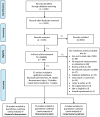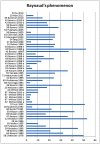Hand-arm vibration and the risk of vascular and neurological diseases-A systematic review and meta-analysis
- PMID: 28704466
- PMCID: PMC5509149
- DOI: 10.1371/journal.pone.0180795
Hand-arm vibration and the risk of vascular and neurological diseases-A systematic review and meta-analysis
Abstract
Background: Increased occurrence of Raynaud's phenomenon, neurosensory injury and carpal tunnel syndrome has been reported for more than 100 years in association with work with vibrating machines. The current risk prediction modelling (ISO-5349) for "Raynaud's phenomenon" is based on a few studies published 70 to 40 years ago. There are no corresponding risk prediction models for neurosensory injury or carpal tunnel syndrome, nor any systematic reviews comprising a statistical synthesis (meta-analysis) of the evidence.
Objectives: Our aim was to provide a systematic review of the literature on the association between Raynaud's phenomenon, neurosensory injuries and carpal tunnel syndrome and hand-arm vibration (HAV) exposure. Moreover the aim was to estimate the magnitude of such an association using meta-analysis.
Methods: This systematic review covers the scientific literature up to January 2016. The databases used for the literature search were PubMed and Science Direct. We found a total of 4,335 abstracts, which were read and whose validity was assessed according to pre-established criteria. 294 articles were examined in their entirety to determine whether each article met the inclusion criteria. The possible risk of bias was assessed for each article. 52 articles finally met the pre-established criteria for inclusion in the systematic review.
Results: The results show that workers who are exposed to HAV have an increased risk of vascular and neurological diseases compared to non-vibration exposed groups. The crude estimate of the risk increase is approximately 4-5 fold. The estimated effect size (odds ratio) is 6.9 for the studies of Raynaud's phenomenon when including only the studies judged to have a low risk of bias. The corresponding risk of neurosensory injury is 7.4 and the equivalent of carpal tunnel syndrome is 2.9.
Conclusion: At equal exposures, neurosensory injury occurs with a 3-time factor shorter latency than Raynaud's phenomenon. Which is why preventive measures should address this vibration health hazard with greater attention.
Conflict of interest statement
Figures

















Comment in
-
Exposure-response relation for vibration-induced white finger: inferences from a published meta-analysis of population groups.Int Arch Occup Environ Health. 2023 Jul;96(5):757-770. doi: 10.1007/s00420-023-01965-w. Epub 2023 Mar 28. Int Arch Occup Environ Health. 2023. PMID: 36976319 Free PMC article.
References
-
- Lawson I, Burke F, McGeoch K, Nilsson T, Proud G. Hand-arm vibration syndrome In: Baxter P, Aw T, Cockcroft A, Durrington P, Harrington J, editors. Hunters Diseases of Occupations. 10th ed London: Hodder Arnold; 2010. p. 489–512.
-
- Pelmear PL, Wasserman DE. Hand-arm vibration. Second ed: OEM Press Beverly Farms, MA; 1998. p. 1–272.
-
- Nilsson T. Neurological diagnosis: aspects of bedside and electrodiagnostic examinations in relation to hand-arm vibration syndrome. Int Arch Occup Environ Health. 2002;75(1–2):55–67. Epub 2002/03/20. . - PubMed
-
- ISO 5349–1. Mechanical vibration—Measurement and evaluation of human exposure to hand-transmitted vibration—Part 1: General guidelines. Draft International Standard. Genevé, Schweiz: International Organization for Standardization, 2001 May 1999. Report No.
-
- Hamilton A. A study of spastic anaemia in the hands of stonecutters. Industrial Accident Hygiene Service Bulletin. 1918:53–66.
Publication types
MeSH terms
LinkOut - more resources
Full Text Sources
Other Literature Sources
Medical
Miscellaneous

